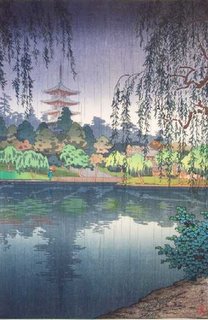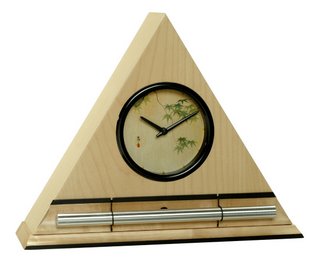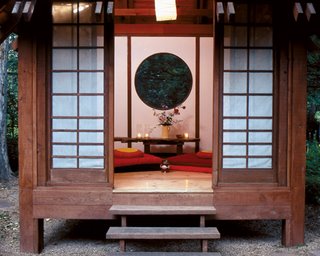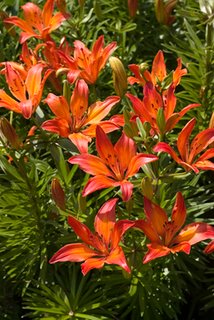|
 Secure Site
Secure Site
|
 |
Archive for the 'Now & Zen Alarm Clocks' Category
 mindful walking Whether you’re staring at a blank page or stuck on a problem, a walk may be just the thing you need to bust through a roadblock. It can even set the stage for inspired thinking and major mental breakthroughs, says Thom Hartmann, author of “Walking Your Blues Away,” by giving you access to the full range of your thought power. “When we walk, we stimulate portions of the brain in the right and left hemispheres, giving us access to more areas of our brains than when we’re sitting still,” he explains. “A million years of evolution have equipped our bodies to operate in an optimal way when we’re walking,” he says. “It’s part of our body’s normal restorative process.” Here are his guidelines for using your daily walk to get out of a mental rut and lure your creativity out into the open.
Skip the Distractions
Wear comfortable clothing, don’t carry anything, and leave the iPod at home. This helps you stay open and balanced so you can focus.
Set a Comfortable Pace
Walk at your normal pace, which helps you sync to your body’s other rhythmic processes, such as heartbeat and breathing rate, which further creates the conditions for insight to occur.
Visualize Your Dilemma
As you’re walking, call up the issue or idea you need clarity on. It can be as richly detailed as a mental image (seeing the finished letter, signed and sealed) or as simple as a question (“What should I say to this person?”). Your mind will inevitably wander; let it. Then, gently guide your thoughts back. Hartmann explains that this interplay between conscious thinking (going over the main points in your mind) and unconscious thinking (daydreaming) brings your whole brain into play and opens you up to inspiration.
Take Your Time
According to Hartmann, the average length of time people require to have a burst in creativity is 15 minutes, or about a mile of walking.
adapted from Body + Soul Magazine, September 2007 by Katie Hanley
 Digital Zen Alarm Clocks, meditation timers and alarm clocks with chimes
Now & Zen
1638 Pearl Street
Boulder, CO 80302
(800) 779-6383
Posted in Chime Alarm Clocks, intention, mindfulness practice, Now & Zen Alarm Clocks, Well-being, Zen Timers
 Kofukuji Temple, Nara Yokoi Outdoor rooms, porches, and pavilions let you come home again to the natural world. Let nature’s elements be your palette and sensory delight your touchstone.
Imagine waking up on a summer morning to a gentle breeze on your face, the chattering of birds, and the scent of flowers opening their petals to the dawn. You lie there, warm under your wool comforter, recalling the bliss of falling asleep with frogs croaking in the nearby pond as you gazed at the stars before closing your eyes. All this, yet indoor plumbing is only a few yards away. This is the joy of outdoor living spaces.
Outdoor rooms, porches, and pavilions are back in style. Tired of being cooped up, people are moving their dining, socializing, sleeping, and sometimes even work spaces outdoors. The success of these spaces depends a lot on understanding some basics about climate and design. If you want your investment in outdoor living to pay off, you’ll want a place that’s comfortable in a range of weather conditions.
Our ancestors, who lived without central heating and cooling, knew a lot about building sleeping porches, gazebos, and summer kitchens. These structures allowed them to escape their hot, stuffy houses in summer. After decades of burning fossil fuels with wild abandon to keep us warm in winter and cool in summer, we’re beginning to realize that these people were on to something. Well-designed outdoor rooms are the epitome of ecological design; they get their heat and light from the sun and their cooling from shade and breezes.
In fact, creating an outdoor space for your home is a great way to increase your grasp of climate-responsive design. It’s an exercise in paying attention to the ecosystems you participate in. By noticing where the prevailing winds come from, and by being aware of the sun’s path across the sky, you can create a garden room that keeps you dry in the rain, unruffled by the wind, cool in summer, and warm in all but the worst of winter without burning a drop of fuel.
Outdoor structures can also expand your home’s living space for much less expense than adding a normal room. And an attached outdoor room can increase your home’s energy efficiency by protecting it from heat, cold, and wind, or even—in the case of a sunspace—by collecting solar heat to be used indoors.
But that’s only the beginning. Outdoor living is also good for your health and well-being. Sunlight, fresh air, and greenery nourish body and soul. The sounds of birds by day and crickets by night, the scent of flowers, the feeling of warm sun and cool breezes on our skin, and the sight of birds, butterflies, and bees nourish our senses and restore our participation in the web of life.
 mother nature's living spaces Try this at home
If you have even a little bit of outdoor space around your home, you can enjoy these delights, too. Start by sitting in different parts of your yard. Notice which areas are sunny, shady, calm, windy, private, exposed, moist, or dry. Notice which spots have nice views, near or far. Think about access: Do you want to walk easily from your indoor kitchen to an outdoor dining room? From a sleeping porch to the bathroom?
When you select a place for an outdoor room, pay attention to how the natural elements interact with this spot, how they vary with the time of day and season, and which elements you’d like to temper for your comfort. Let’s say you want to build a pavilion in a corner of your backyard, but the prevailing wind comes from the northwest—which is exactly the direction of your favorite view. A glass wall on the northwest side will meet both your needs. Or maybe you want to create a warm spot for chilly evenings. You can build a curved stone wall that defines the space, blocks the breeze, and faces south to soak up the sun; build a stone bench against the wall, and you’ll have a toasty spot for relaxing at the day’s end. Overhead shade will make the same spot comfortably cool in summer.
Finally, consider having flexible elements that extend the usefulness of your outdoor space. Add removable glass to a screened porch to turn it into a sunroom in winter. Use heavy curtains in your pavilion to block breezes, rain, or prying eyes. Hang a seasonal cloth roof over a patio, or grow a deciduous vine on a trellis or arbor.
adapted from Natural Home Magazine, July/August 2004
 Japanese Maple Leaves Dial Face, Zen Wake-up Alarm Clock Now & Zen
1638 Pearl Street
Boulder, CO 80302
(800) 779-6383
Posted in Cherry Blossoms, Chime Alarm Clocks, Japanese Inspired Zen Clocks, Natural Awakening, Now & Zen Alarm Clocks, sleep, Sleep Habits, Ukiyo-e, wake up alarm clock
 entering silence, starry night in the wilderness How one woman survived three days in the wilderness—alone.
I shivered in the pitch-black night as a steady rain showered my head. I sank deeper into a state of abject loneliness with every miserable drop. My saturated sleeping bag weighed me down as I searched blindly for my flashlight, all the while berating myself for not tying up the tarp before I fell asleep beneath a formerly clear, starry night.
Feeling panicky on the first night of my solo experience in the woods, I imagined the worst—three days of rainy, damp desolation. What am I doing here? I wondered. I could be home, snuggled up with my husband in our cozy bed!
And then it hit me. I realized that this moment was exactly why I had come here—to face my demons head-on, to ride out the fear of being alone in the dark and of being eaten, possibly, by a bear. Isn’t that what a vision quest is all about? Flinging oneself into the wilderness (in this case, a California state park on Labor Day weekend, but still) to test one’s inner strength and hopefully receive some sort of life guidance, perspective, and inspiration?
For the last 10 years, I had contemplated embarking on a quest like this with awe and trepidation. An extrovert by nature, I thrive on the company of others. I can’t be alone in my own house for five minutes without feeling anxious, so how could I endure three entire days by myself? I feared I would go crazy with no one to talk to, engulfed by the deafening silence of nature.
To my surprise, I discovered that nature is extremely loud. Have you ever heard throngs of blue jays chattering overhead at the crack of dawn? I was definitely not alone—from the disturbed gopher under my sleeping bag (was I camped on his house?) to the constant parade of insects, birds, and critters, I was in a forest teaming with life and endless entertainment.
Two days later as I packed my gear, I had a hard time believing the time had passed so quickly. Suddenly the power of facing and overcoming my deepest fears overwhelmed me, and I fell to my knees sobbing. A strength I never knew existed inside me welled up as I realized I could now be alone and unafraid.
I shouldered my backpack, danced a little jig to celebrate my emancipation, and walked out of the wilderness a changed woman.
adapted from Natural Solutions Magazine, Sept. 2009 by Laura Gates
 Zen Alarm Clock, a natural chime sound alarm clock
Now & Zen
1638 Pearl Street
Boulder, CO 80302
(800) 779-6383
Posted in Bamboo Chime Clocks, Chime Alarm Clocks, Hokusai Wave, intention, Natural Awakening, Now & Zen Alarm Clocks, Progressive Awakening, sleep, Well-being
 meditation in motion, walking mindfulness practice Attention, multitaskers: Want to exercise and meditate at the same time? Try Breathwalk, a form of walking meditation that incorporates pranayama and mantra techniques from the Kundalini Yoga tradition. The late Yogi Bhajan introduced this practice to the West in the early 1970s. Since then, yoga students of all shapes and sizes have used it to improve their cardiovascular health, tone their nervous system, boost their energy, stabilize their moods, quiet mental chatter, and embrace the present moment. In its full form, Breathwalk is a five-step process that can take up to 60 minutes; here’s an abbreviated routine you can do in less than 20. Try it in a meadow, on the beach, in the woods, or, if you’re feeling adventurous, on a city street.
The Practice
Begin walking at a normal pace, observing your bodily sensations. Then tune into your breath. Are you breathing with your chest muscles or with your diaphragm? Is your breath shallow and erratic or smooth and deep? Noisy or quiet? Through your mouth or through your nostrils? Gradually refine your breath so that it becomes nasal, diaphragmatic, and free of noise and irregularities.
Now coordinate your breath with your stride, inhaling for four steps and exhaling for four steps. When this feels comfortable and automatic, begin to practice the following breathing pattern: Keeping your nasal passages and facial muscles relaxed, take four short staccato puffs of air through the nostrils—one puff for each step. (Your breath will be audible now; focus on the sound.) Essentially, you are dividing your inhalation into four segments that are synchronized with four consecutive steps. After the first puff, your lungs should be about one-quarter full; after the second, two-quarters full; after the third, three-quarters full; and after the fourth, four-quarters full.
 zen stones Without pausing, exhale in the same fashion, contracting the abdominal muscles and pushing the navel to the spine for four steps (and four segments of the out-breath), so that the final puff pushes the last quarter of air out of your lungs. Continue this pattern for five minutes, then walk and breathe normally for three minutes. As Gurucharan Singh Khalsa, senior student of Yogi Bhajan and co-author of Breathwalk, says, “It’s not about, ‘How far did I walk, how many calories did I burn, how much effort was expended?’ It’s about synchronizing the body, breath, and mind to the present moment, about experiencing a profound sense of connection with yourself and nature.”
Now, repeat the eight-minute practice. This time, as you synchronize your segmented breath with your stride, mentally say the mantra sa ta na ma—one sound for each step and each segmented breath. Repeat the mantra in coordination with the quartered breath for five minutes, then walk and breathe normally for another three.
“Practice for three days in a row and you’ll feel the energizing, focusing effects immediately,” Khalsa says. “If you do it for 40 days you can get really intimate with the technique. You can slip it into the cracks of your day to support you—that’s its purpose.”
adapted from Yoga International, by Shannon Sexton
 Tibetan Meditation Timer with Brass Singing Bowl Now & Zen
1638 Pearl Street
Boulder, CO 80302
(800) 779-6383
Posted in Bamboo Chime Clocks, Meditation Timers, Meditation Tools, mindfulness practice, Now & Zen Alarm Clocks, Zen Timepiece by Now & Zen, Zen Timers
 Lake Meditation Lake Meditation
Move your attention from the mountain to the lake. Crystal-clear, turquoise-hued lakes toward the peak of some mountains in the Himalayas are called “sky lakes” because they so perfectly reflect the sky above. Protected by the higher peaks and trees, the surface of such a lake is smooth and calm. You don’t need to visualize yourself as a lake. Rather, contemplate the lake and its quality of reflectivity. Notice how the water is translucent, allowing you to see into its depths. Notice how it is also as reflective as a mirror, so you can see your face and the sky above on its surface. As you imagine yourself looking into the surface of the water, notice how the water reflects only what is there, neither editing out nor adding in anything. The water reflects the dark, ominous storm clouds and the fluffy white clouds equally. When birds fly overhead, the water reflects them; yet once they are gone from the sky, it shows no trace of them.
When the waves (vritti) are calmed, the mind (citta) has this dual ability of the lake to be both translucent and reflective. Once your mind is stabilized, you can turn your attention to it. Imagining your mind to be as translucent and reflective as the sky lake may bring forth thoughts, feelings, and emotions, but you can simply reflect what arises without judging or comparing, and without editing out anything through aversion or denial. Perceptions of sound, smell, or touch may arise, and, free of grasping and pushing away, you can simply reflect. In this way, destructive or unwholesome patterns can be seen, so that their power over you is lessened. Attachments are loosened. Breathing in, see yourself as the water of the sky lake; breathing out, reflect.
adapted from Yoga Journal, by Frank Jude Boccio
 Zen Chime Alarm Clock and Timer Now & Zen
1638 Pearl Street
Boulder, CO 80302
(800) 779-6383
Posted in Bamboo Chime Clocks, intention, Meditation Timers, Meditation Tools, mindfulness practice, Now & Zen Alarm Clocks
 giving thanks Cultivating gratitude can boost well-being—and may help you sleep better.
Gratitude is a fundamental component of most spiritual paths, and a growing body of research suggests that it has important health implications, too, including better sleep, fewer physical ailments, and a greater ability to cope with stressful situations.
“Gratitude elevates, it energizes, it inspires, it transforms,” says Robert Emmons, a University of California, Davis, psychology professor who has helped champion the study of gratitude as a factor in mental and physical health.
A series of studies he conducted in 2003 found that people who kept weekly written records of gratitude slept longer, exercised more frequently, had fewer health complaints, and generally felt better about their lives when compared with those who were asked to record only their complaints. In another study, he found that students who wrote in gratitude journals felt more satisfied with their lives and their school experience.
Practicing conscious gratitude has also been linked with positive mental health. Todd Kashdan, associate professor of psychology at Virginia’s George Mason University, found that when veterans with posttraumatic stress disorder kept gratitude journals, they experienced a greater sense of overall well-being in their lives. “There are two parts of being grateful,” Kashdan says. “One is recognizing that someone benefited in some way, then mindfully seeing the connection to yourself. You have to really be in the present to see what’s happening in your life, what’s causing things to happen, and how you fit into things bigger than yourself.”
A gratitude practice is a natural companion to yoga, which “offers numerous opportunities to reflect on all there is in one’s life to be grateful for,” says Emmons. To begin consciously cultivating gratitude, try considering what life would be like without a pleasure you now enjoy, or think about who you are grateful for. A daily gratitude journal can help you be more mindful of these things in your life. But your gratitude practice doesn’t have to be scripted: Simply taking time on a regular basis to mentally note your blessings is a big step in the right direction.
adapted from Yoga Journal, by Jill Duman
Posted in Bamboo Chime Clocks, Chime Alarm Clocks, intention, mindfulness practice, Now & Zen Alarm Clocks
 Silk Lavender Eye Pillows Creating Eye Pillows:
Summer holidays are perfect times for craft projects. Here’s one you can do in an hour and use right away. Eye pillows are handy for traveling and for relaxing in Savasana.
Materials You’ll Need (makes one eye pillow)
For the pillow
1/2 yard of fabric that has been washed, dried, and ironed
For the filling
1/2 cup dried beans or flax seeds
1/2 cup dried rice, lentils, or buckwheat
1/2 cup dried lavender or chamomile
When selecting the filling consider the recipient’s scent preferences and any potential allergies. Mix together three or all of the above items. You’ll need 1 1/2 cups total.
 creating beautiful eye pillows Make the Pillow
Step 1 Cut the fabric
Using a ruler and pencil, mark two 4 1/2-by-10-inch rectangles on the wrong (nonprinted) side of the fabric. With a pair of scissors, cut along the marks to create the two panels needed for the pillow.
Step 2 Sew the seams
Place the two panels’ right (printed) sides together, with the raw edges aligned. Stitch a 1/2-inch seam around the raw edges, backstitching (sewing first in reverse, then forward over the same stitches) at each end. Leave one of the 4-inch sides open, so you can later add the filling. Stitch a 3/8-inch reinforcement seam around the raw edges, leaving the same 4-inch opening. This reinforcement will ensure that the mixture doesn’t leak out of the pillow after you’ve filled it.
With your scissors, cut two 1/4-inch notches in each seam allowance (the area between the stitching and the raw, cut edge of the fabric), one on either side of each of the four corners, making sure not to clip the stitching. Turn the eye pillow right side out for the next step.
Step 3 Fill the pillow
Spoon 1 1/2 cups of filling into the pillow’s open seam.
Step 4 Close the final seam
Fold each side of the remaining 4-inch seam 1/2 inch toward the inside of the pillow, and pin the opening closed. Either by hand or with a sewing machine, stitch a seam across the folded edges to close the 4-inch opening, then try out the pillow: Set your Zen Meditation Timer to 5 minutes, lie down, put it over your eyes, and treat yourself to 5 minutes of deep relaxation.
adapted from Yoga Journal, by Victoria Everman
 Zen Mediation Timers Now & Zen
1638 Pearl Street
Boulder, CO 80302
(800) 779-6383
Posted in Chime Alarm Clocks, Meditation Timers, Meditation Tools, mindfulness practice, Now & Zen Alarm Clocks, Well-being, Zen Timers
 Flecked with water lilies and fringed with greenery, a heart-shaped pond exemplifies the spirit of the Osmosis Meditation Garden. A stone path leads visitors across a small bridge to the Moon Pavilion In the West, gardens are designed for outdoor living as much as for viewing. Japanese gardens, on the other hand, are more for viewing ― to communicate peace and tranquility. The new Meditation Garden at the Osmosis spa in Freestone blends the two approaches. “It’s a Japanese-style garden created for California,” says owner Michael Stusser. The design, by Robert Ketchell, founder of the British Japanese Garden Society, is Japanese, but the use of California native plants and the lovely coastal-hills setting tie it directly to the region.
What makes it so serene? A mirror-smooth pond reflects the day’s changing light and passing clouds. Plantings are simple yet sculptural: a single conifer beside a shapely boulder in one area, a Japanese maple and several conifers in another. Gravel raked in swirls around boulders evokes the feeling of water.
Like Japanese gardens, the Meditation Garden is meant to be viewed through a moon window in the pavilion near the pond. But like a California garden, it invites you in to feel the tranquility.
INFO: Osmosis: The Enzyme Bath Spa (209 Bohemian Hwy., Freestone; 707/823-8231) celebrates its 20th anniversary on Sep 9 with a concert and sushi buffet ($65); tickets limited.
Osmosis is having a 25 year anniversary celebration on September 12th with food music and complementary cedar enzyme foot baths. The cost is $25.
Garden tours are planned for every Sunday in October between 11am and 3:00pm
adapted from Sunset Magazine, by Lauren Bonar Swezey
Posted in Bamboo Chime Clocks, Hot Springs, Now & Zen Alarm Clocks, teahouse, Well-being
 Reiki Treatment Reiki, a Japanese healing treatment, quiets the body and spirit by tapping into a “life force.”
“Universal life energy” is what Reiki (pronounced RAY-kee) means in Japanese. Reiki practitioners use this energy-the subtle vibrational force that surrounds and permeates every living thing- to enhance and balance the body, says Susan Mitchell, a Reiki master and owner of Reiki Healing Arts in Coeur d’Alene, Idaho. “The practitioner acts as a conduit,” explains Beth White, a Reiki master in New York City. “During a session, the energy flows through the practitioner’s hands and you absorb it on a physical, mental, emotional, and spiritual level.” The result? A feeling of meditative peace.
Evidence
Reiki originated in Japan in the 1920s and was brought to the United States in the 1930s by Hawayo Takata, a Japanese-American. Although the studies of Reiki thus far have been small (five larger ones sponsored by the National Institutes of Health are under way), they indicate-as does strong anecdotal evidence-that the method is effective at reducing pain, anxiety, and stress, and increasing a sense of wellbeing. A study published last year in Integrative Cancer Therapies compared the effects of Reiki treatments with the effects of rest on fatigue, pain, anxiety, and overall quality of life in 16 cancer patients. Researchers found that the individuals who received Reiki experienced increases in quality of life and decreases in fatigue, changes that were not seen with rest alone.
Pamela Miles, a Reiki master in New York City and author of Reiki: A Comprehensive Guide (Tarcher, 2006), says the physiological changes seen following a Reiki session include a healthy decrease in heart rate and blood pressure and an increase in salivary immune hormones. “Reiki can help make your body’s self healing mechanism more effective,” she says. “Universal life energy” is what Reiki (pronounced RAY-kee) means in Japanese. Reiki practitioners use this energy-the subtle vibrational force that surrounds and permeates every living thing- to enhance and balance the body, says Susan Mitchell, a Reiki master and owner of Reiki Healing Arts in Coeur d’Alene, Idaho. “The practitioner acts as a conduit,” explains Beth White, a Reiki master in New York City. “During a session, the energy flows through the practitioner’s hands and you absorb it on a physical, mental, emotional, and spiritual level.” The result? A feeling of meditative peace.
 Reiki Evidence
Reiki originated in Japan in the 1920s and was brought to the United States in the 1930s by Hawayo Takata, a Japanese-American. Although the studies of Reiki thus far have been small (five larger ones sponsored by the National Institutes of Health are under way), they indicate-as does strong anecdotal evidence-that the method is effective at reducing pain, anxiety, and stress, and increasing a sense of wellbeing. A study published last year in Integrative Cancer Therapies compared the effects of Reiki treatments with the effects of rest on fatigue, pain, anxiety, and overall quality of life in 16 cancer patients. Researchers found that the individuals who received Reiki experienced increases in quality of life and decreases in fatigue, changes that were not seen with rest alone.
Pamela Miles, a Reiki master in New York City and author of Reiki: A Comprehensive Guide (Tarcher, 2006), says the physiological changes seen following a Reiki session include a healthy decrease in heart rate and blood pressure and an increase in salivary immune hormones. “Reiki can help make your body’s self healing mechanism more effective,” she says.
A typical session
During a Reiki treatment, you lie down on a massage table while the practitioner places her hands in various positions on your head, throat, and front and back torso. (Clients are fully clothed, unless Reiki is used in combination with another treatment like a massage.) You may enter a state of deep relaxation. Many people report seeing colors and moving shapes, sensing pulsations, and feeling hot or cold. In many cases, though, the result is improved energy and a sense of wellbeing. “I go into what feels like a deep sleep,” says Spiegler, “and an hour later I ‘wake up,’ feeling totally rejuvenated.”
adapted from Natural Health Magazine, August 2008 by Susan Hayes
 Bamboo Digital Chime Clock, a Reiki Timer and Clock Now & Zen
1638 Pearl Street
Boulder, CO 80302
(800) 779-6383
Posted in Bamboo Chime Clocks, Chime Alarm Clocks, intention, Japanese Inspired Zen Clocks, mindfulness practice, Now & Zen Alarm Clocks, Well-being
Kyoto meets Giverny in this artful garden, a sublime space for contemplation.
 teahouse, photo by Povy Kendal Atchison Japanese shoji screens traditionally are made from translucent rice paper, but the owners chose a durable, light-penetrating fabric that will prevail in harsh weather. It allows filtered light without sacrificing privacy. The floor is salvaged pine planks from a park ranger’s mountain cabin, and a round window brings in the garden even when the doors are closed.
Ten years ago, a Boulder, Colorado, couple bought a house on a patch of grass with some overgrown shrubs, sliced by an irrigation ditch. Where many people might have seen desolation, these intrepid gardeners saw the opportunity to create a private world of solitude and renewal. In the process, they discovered that designing and planting is as soothing as enjoying the completed garden.
The contemplative garden they’ve created gently nods to Asian style while embracing European impressionism. It borrows from 19th-century impressionist painter Claude Monet, as well as from the Japanese love of plant textures, weeping trees and artfully placed rocks. It includes water, rocks, expanses of greenery and winding paths, but not the formal Japanese plantings that require so much upkeep.
Monet’s famous garden in Giverny, France, includes a Japanese bridge over a water lily pond. In this Colorado garden, a pale-aqua bridge arches over an irrigation ditch that’s been funneling water to farmers for 100 years. Just as the lily pad pond became the Monet garden’s major draw, the ditch has been transformed—lined with sandstone rocks alongside a bed of river rocks. Gold, yellow and orange daylilies drape the bank, blooming in midsummer when the Siberian and Japanese irises offer only seed pods. Ornamental grasses bend and sway to the breeze stirred up by the water’s flow. The ditch is an enticement; visitors brace against the railing and peer into the water, watching blossoms float downstream.
Every corner of this garden was designed with careful thought, not lavish funds. A decade of hard work and trial-and-error provided an education.
Piecing together elegance
Every corner of this garden was designed with careful thought, not lavish funds. A decade of hard work and trial-and-error provided an education. In hindsight, the homeowners believe their decision to tackle their garden in small pieces rather than taking on the entire half-acre saved them time, money and frustration.
“We didn’t have a grand master plan,” one of the homeowners admits. Instead, he started by clearing dead and dying trees. Then he parceled the property into smaller gardens: a ditch lined with water-loving plants and flagstones circles the edges of the gardens and is sprinkled with elfin thyme and other herbs for groundcover.
To imitate nature’s undulating, uneven landscape, he built mounds, or berms, from garden soil, adding interest to the flat piece of land. Berms also provide quick drainage for plants that might never take hold without humus and gravel. Sun-loving plants such as foxtail lilies and peonies are located on the sunny mounds. Shade-loving hostas line the flagstone walkways under giant locust trees.
“It all came together like a jigsaw puzzle,” the gardener says, with groundcovers of thyme and vinca, creeping veronica, wild strawberries and sweet woodruff. Groundcovers that can become invasive thugs, such as the sweet woodruff, were banished to the riverbank under the house, where it can duke it out with ornamental strawberries for space and light.
What’s in this garden?
• Crabapple trees (Malus spp), highly adaptable to most weather and soil conditions, have exquisite spring blooms. The weeping varieties include Red Jade, Coral Cascade, White Cascade and Louisa. Best to order from your local garden center.
• Species (or wild) tulips (Tulipa spp) have brilliant hues and hardiness. Long before more formal tulips became the backbone of Dutch gardens, miniature species tulips blanketed hillsides in Turkey. Most only can be grown in climates with winter temperatures. Order from trustworthy companies (see “Resources,” below) that propagate their own bulbs and do not harvest from the wild.
• Foxtail lilies (Eremurus spp) have attention-grabbing feathery spikes and day-glow colors. They’re easy to grow, but they do require good drainage to avoid root rot.
• Thyme (Thymus spp) may be slow to start, but once established, it tolerates some foot traffic. Best as filler between stepping stones, aromatic thymes will creep around rocks and steps, choking out weeds.
• Daylilies (Hemerocallis spp) have sweeping, grasslike foliage and arching blooms. Each blossom lasts only one day, but the plant blooms nonstop throughout summer. They require little care aside from division every few years, and only a moderate amount of water.
 daylilies • Irises (Iris spp) are easy to grow if you choose the right cultivars for your garden. Siberian and Japanese irises grow best in moist, slightly acid soil, perhaps on the banks of a pond or stream. For alkaline soil and aridity, choose bearded irises. And if you love variegated leaves of white and green, look into Iris pallida.
• Hostas (Funkia spp), with wide, variegated leaves, add to foliage interest rather than floral displays. Lords of the shade garden, hostas can be found in a variety of sizes, some with blue-tinged or gold coloration and heart-shape leaves. All need some moisture and dappled shade.
Four seasons of splendor
In this garden, bold plants such as peonies and foxtail lilies are the prima donnas—showy and extravagant with heavy blooms. Other beauties are far smaller and require a closer look. Brilliant red and yellow species tulips—more natural looking than their formal, hybrid cousins—pop up among drifts of thyme. Delphiniums and their smaller brethren, larkspur, join foxgloves for height and extravagant color. Oriental poppies and California poppies display papery petals, popping up in mounds and drifts.
 oriental poppy In early spring, the bright blues and purples of the groundcovers cluster throughout the garden, complementing the species tulips’ tiny blooms. By late spring, foxgloves and Siberian and Japanese irises dominate. Summer is golden, as daylilies offer orange, yellow and cream colors.
The garden may be at its best in winter, the gardeners claim. Japanese lanterns guide visitors down the flagstone footpath, and snow sets a black-and-white scene. Bare, weeping crabapple branches bend gracefully like sculpture. “Some of the most beautiful times in the garden are in the snow,” the homeowner says. “You see all the shapes that don’t go away: the mounds, rocks, ornaments, trellises.”
Reflecting in the teahouse
Autumn and winter usher in the garden’s quiet moments, when trowels are put away. A tiny teahouse, built of salvaged cedar siding left over after the house was built, holds sway. Once inside, a cup of hot tea banishes the cold. Sliding shoji screen doors open to the sparkling light on snow or close to keep out a brisk wind. The nine-by-nine-foot teahouse anchors this garden, a reminder that its primary purpose is to promote meditation and reflection rather than busyness. A Zen Timepiece adornes the interior so that one can timer their meditation practice. The naked branches of an old cottonwood tree loom over the teahouse while smaller pines and dwarf evergreens screen the street and neighborhood. “The teahouse gave us a focus for the garden,” the homeowner says, “and cut down the amount of lawn.”
In winter’s stillness, when birds are silent, only the bamboo wind chimes clink softly. The teahouse’s back wall features a round window that provides the most private views and connects the garden to the teahouse. “I wanted a big round window,” the owner says, “to bring the outside in.”
 Zen Timepiece with brass singing bowl, a meditation timer. adapted from Natural Home Magazine, March/April 2008 by Niki Hayden
Now & Zen
1638 Pearl Street
Boulder, CO 80302
(800) 779-6383
Posted in Bamboo Chime Clocks, Chime Alarm Clocks, Japanese Inspired Zen Clocks, Now & Zen Alarm Clocks, teahouse, Well-being, Zen Timepiece by Now & Zen, Zen Timers
« Previous Page — « Previous Entries
Next Entries » — Next Page »
|
|
|
|